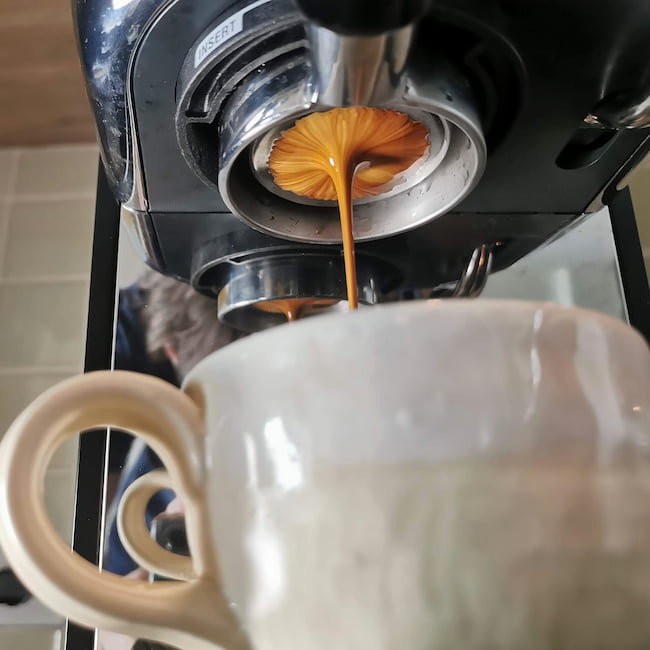There’s nothing quite as horrible as sour espresso.
Because espresso is so concentrated, all flavors are much more in your face than any other type of coffee.
For that reason, it’s so crucial to have a balanced shot of “spro.”
Espresso is NOT supposed to be sour! Don’t trust anybody who tells you that 🙅
Here are my best tips on how to avoid it.
1: Choose the right type of bean
In general, it’s just a lot easier to extract medium or dark roasts, rather than many of the lighter roasts that are in fashion these days.
Since espresso extraction happens so fast, it can be challenging to get pull lighter roast shots properly. Hence, you stand a much better chance to avoid sourness if you get a bean that inherently is less sour.
Simple logic, really.
Imagine a bean that is excellent for pour over. Then take the same flavor compounds and make them 7-10 times more concentrated. Now it’s just too much.
It’s the same with lemon juice. Pure it’s too much, but mixed into a glass of water, it’s less overwhelming—concentration matters.
Yes, yes. I know that hip, modern roasters only offer light stuff. But do you want to be cool or drink good coffee? Light roasts require high-end grinders, high-end espresso machines with PID temperature control and preinfusion as well as a lot of extraction knowledge.
Unfortunately, not all people have that.
You’ve got to work with the equipment you have at home and make a drink that’s enjoyable for you. Don’t care about what everyone else is brewing on Instagram.
For that reason I think it’s not a bad idea to start out with espresso coffee beans roasted and blended specifically for espresso. A humble Lavazza blend for example.
2: Use longer ratios
If you neglect my advice, and you still want to use relatively light roasts for espresso, there is one essential tip that you must follow.
Use longer ratios!
The 1:2 ratio is often quoted as the essential espresso recipe. However, this is a very concentrated shot that is more suited for darker roasts.
The first flavors that are extracted are typically the bitter flavors and the acids. Only after that comes the sweetness.
By stretching the ratio a bit longer (1:2.5 to 1:3), you extract more sweetness from the bean while also diluting the shot a bit.
I think that some beans are even too light for a 1:3. Those coffees are often worth trying in a lungo or allongé instead.

3: Focus on water
Water is an often overlooked ingredient in coffee. Unfortunately, when it comes to espresso, it’s even more neglected.
Most people think that the water should be suitable for the machine’s health, which means that it shouldn’t cause scale.
Yes, you should definitely be mindful of the machine.
However, you should also remember that water can help you manage acidity.
Bicarbonate is usually seen as undesirable compound in coffee brew water since it acts as a buffer, which counteracts fluctuations in pH.
Acidity or sourness actually means a lower pH. So by using water with a higher level of bicarbonates, you can essentially smoothen out your espresso a bit more.
Now, the tricky thing is that water with a high level of bicarbonates typically also has a high amount of scale-causing calcium. But you can find softened water or create your own alkalinity concentrate and add it to your brew water. For instance, so-called “Rpavlis” water is scale-free while being jam-packed with alkalinity.
4: Brew at higher temperatures
High temperatures tend to transform acidity into sweetness when we’re dealing with very light roasts. That’s the case when it comes to manual brewing, but also when we’re talking about espresso.
If you have a built-in PID in your espresso machine, you’re lucky. Then it’s easy.
If you have a manual lever machine like the Flair or Robot, you have to preheat as much as possible!
If you have a standard espresso machine, you might have to preheat the portafilter and group head. You might have to leave your machine on for a while. You might have to temperature surfer.
Do everything you can to raise the brew temperature!
5: Extend brew time

Lighter coffees are dense coffees. Dense coffees are hard to extract because they are less soluble in water. Extending brew time can help you get the job done.
- Preinfuse: If you have the option to preinfusion, it can do wonders to hit the puck with 10 to 45 seconds of preinfusion. However, not all machines can do this.
- Grinding finer is another thing worth trying. This opens up a bigger surface area of the beans, making it easier for the water to penetrate every particle to the core. Grinding finer also slows down the water flow, so at the same time, you’re extending brew time and increasing pressure; both are aspects that increase extraction.
